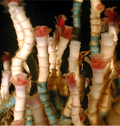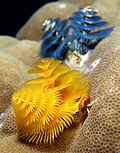Polychaete
Polychaetes or polychaeta (Greek: πολύς, polys; "many" and χαίτη, chaite; "long hair") are a paraphyletic class of annelid worms, generally marine. They are also known as bristle worms due to the presence of bristles, or chaetae, which are arrayed along their parapodia (lateral "feet").
Anatomy and Morphology[edit]
Polychaetes exhibit a wide range of morphologies, but are typically characterized by well-developed heads and segmented bodies. Each body segment has a pair of fleshy protrusions called parapodia that bear many bristles, or chaetae, which are made of chitin.
Ecology and Life Cycle[edit]
Polychaetes occupy a wide range of marine environments, from tidal zones to hydrothermal vents. They play key roles in the benthic (bottom-dwelling) ecology of many marine communities. The life cycle of polychaetes varies widely, but can generally be characterized by both sexual and asexual reproduction.
Classification[edit]
Polychaetes are a class within the phylum Annelida. They are divided into many families and include over 10,000 species. Some well-known groups include the lugworms (Arenicolidae), the clam worms (Nereididae), and the fan worms (Sabellidae).
Research and Importance[edit]
Polychaetes are important both ecologically and economically. They are a major part of the diet of many marine animals, and their burrowing activities play a significant role in sediment mixing. Economically, some species are harvested for bait, while others are important in the degradation of organic pollutants.
See Also[edit]
References[edit]
<references />
|
|
|
-
Polychaete
-
Polychaete anatomy
-
Phyllodoce rosea
-
Alvinella pompejana
-
Hesiocaeca methanicola
-
Lamellibrachia luymesi
-
Eunice aphroditois
-
Phyllodoce lineata
-
Pacific Feather Duster Sabellastarte sp.
-
Tomopteris
-
Spirobrancheus giganteus
-
Nereis pelagica
Ad. Transform your life with W8MD's Budget GLP-1 injections from $75


W8MD offers a medical weight loss program to lose weight in Philadelphia. Our physician-supervised medical weight loss provides:
- Weight loss injections in NYC (generic and brand names):
- Zepbound / Mounjaro, Wegovy / Ozempic, Saxenda
- Most insurances accepted or discounted self-pay rates. We will obtain insurance prior authorizations if needed.
- Generic GLP1 weight loss injections from $75 for the starting dose.
- Also offer prescription weight loss medications including Phentermine, Qsymia, Diethylpropion, Contrave etc.
NYC weight loss doctor appointmentsNYC weight loss doctor appointments
Start your NYC weight loss journey today at our NYC medical weight loss and Philadelphia medical weight loss clinics.
- Call 718-946-5500 to lose weight in NYC or for medical weight loss in Philadelphia 215-676-2334.
- Tags:NYC medical weight loss, Philadelphia lose weight Zepbound NYC, Budget GLP1 weight loss injections, Wegovy Philadelphia, Wegovy NYC, Philadelphia medical weight loss, Brookly weight loss and Wegovy NYC
|
WikiMD's Wellness Encyclopedia |
| Let Food Be Thy Medicine Medicine Thy Food - Hippocrates |
Medical Disclaimer: WikiMD is not a substitute for professional medical advice. The information on WikiMD is provided as an information resource only, may be incorrect, outdated or misleading, and is not to be used or relied on for any diagnostic or treatment purposes. Please consult your health care provider before making any healthcare decisions or for guidance about a specific medical condition. WikiMD expressly disclaims responsibility, and shall have no liability, for any damages, loss, injury, or liability whatsoever suffered as a result of your reliance on the information contained in this site. By visiting this site you agree to the foregoing terms and conditions, which may from time to time be changed or supplemented by WikiMD. If you do not agree to the foregoing terms and conditions, you should not enter or use this site. See full disclaimer.
Credits:Most images are courtesy of Wikimedia commons, and templates, categories Wikipedia, licensed under CC BY SA or similar.
Translate this page: - East Asian
中文,
日本,
한국어,
South Asian
हिन्दी,
தமிழ்,
తెలుగు,
Urdu,
ಕನ್ನಡ,
Southeast Asian
Indonesian,
Vietnamese,
Thai,
မြန်မာဘာသာ,
বাংলা
European
español,
Deutsch,
français,
Greek,
português do Brasil,
polski,
română,
русский,
Nederlands,
norsk,
svenska,
suomi,
Italian
Middle Eastern & African
عربى,
Turkish,
Persian,
Hebrew,
Afrikaans,
isiZulu,
Kiswahili,
Other
Bulgarian,
Hungarian,
Czech,
Swedish,
മലയാളം,
मराठी,
ਪੰਜਾਬੀ,
ગુજરાતી,
Portuguese,
Ukrainian














